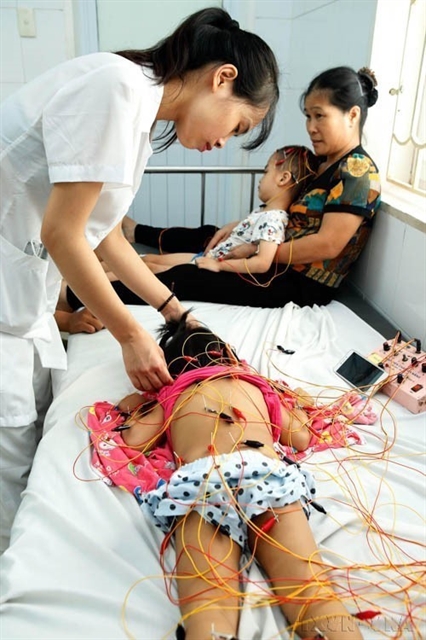May 8, 2025
HANOI – By integrating traditional eastern medicine with modern speech and communication therapy, the Hà Nội-based National Hospital of Acupuncture is bringing renewed hope to families of children with autism.
Many young patients have shown significant improvements in communication and social integration. Some, like P.Đ.D., from Lào Cai Province, are even preparing to start school with confidence.
D.’s world used to be quiet and distant. At just 33 months old, he was brought to the National Hospital of Acupuncture in Hà Nội for treatment after his family noticed signs that set him apart.
“He wasn’t speaking at all. He wouldn’t turn his head when we called him, like he couldn’t hear us,” recalled K., D.’s grandfather.
“He rarely made eye contact, walked on his tiptoes, loved to spin around and climb everything, and showed signs of intellectual delay.”
Concerned, the family turned to the Hà Nội-based hospital known for combining acupuncture, massage and traditional therapies with modern language intervention techniques. From that moment, the hospital became like a second home to D.
Over the course of more than two years, his grandparents and parents took turns accompanying him on his 21-day treatment sessions in the capital.
Each day brought a rigorous routine: acupuncture, therapeutic massage, pressure point stimulation, speech therapy and communication exercises.
“Every day was a test of willpower,” K. said. “We were driven by love for D., but also had to cope with the disruptions to our family life.”
The results, however, have been nothing short of transformative. By the age of four, D. could speak and respond when called. His hyperactivity had decreased, and he was able to make eye contact when addressed. His teachers noticed marked progress in his intervention sessions.
“From a child who couldn’t speak, whose cognitive development was like that of an infant, and who used to run and jump uncontrollably – after nearly three years of consistent treatment, he has come a long way,” K. shared with pride.
“He now recognises letters, can add and subtract. At this point, we could stop the treatment, but we’ve decided to continue until August so he can confidently start first grade alongside his peers,” he said.
Holistic approach
At the National Hospital of Acupuncture, traditional medicine is being creatively integrated into modern therapies to support children with autism spectrum disorder (ASD). Over the past several years, thousands of young patients have been treated, benefitting from a unique blend of acupuncture and developmental interventions.

The National Hospital of Acupuncture integrates modern medicine with traditional therapies in treating a child with autism. PHOTO: VNA/VIET NAM NEWS
Dr Nguyễn Tuấn Anh, deputy director of the hospital’s Centre for the Treatment and Care of Children with Autism and Cerebral Palsy, explained that ASD is a lifelong developmental disorder that severely impacts a child’s ability to communicate, relate socially and engage in imaginative play.
“Symptoms and severity vary widely,” he noted, “and no single intervention has been deemed optimal. That’s why we combine multiple methods to maximise treatment outcomes.”
Traditional eastern medicine works by restoring the balance of yin and yang and harmonising the internal organs. In clinical practice, acupuncturists select specific acupoints based on the child’s individual condition, according to Tuấn Anh.
“Each acupoint connects to one or more organs through energy channels, and stimulation at these points can help regulate physiological functions and address pathological changes,” he explained.
Stimulating these points, whether through acupuncture, electro-acupuncture or thread embedding, can influence brain activity, enhance cerebral blood flow and improve alertness and cognitive function.
Children are treated with a combination of non-pharmacological methods, traditional remedies and various rehabilitation techniques including speech-language therapy, motor therapy, Applied Behaviour Analysis, sensory integration therapy and inclusive education.
At the core of this integrative treatment are six primary methods: electro-acupuncture, aquapuncture, massage and acupressure, auricular acupuncture, thread embedding and educational intervention.
Because children with ASD often exhibit hyperactivity and difficulty staying still, early sessions typically use fewer needles and avoid electrical stimulation to help the child acclimate gradually. Parents are encouraged to participate during treatments by talking, reading stories or showing affection to help the child feel safe and engaged.
Each treatment course typically lasts 20 days, followed by a seven- to ten-day break. The facility is equipped with functional rooms for assessment, individual and group therapy and family support, ensuring that each child receives a personalised care plan.
Advanced techniques such as aquapuncture, electro-acupuncture, auricular therapy and dissolvable thread embedding further enhance therapeutic outcomes.
Early intervention matters
Drawing from thousands of cases, Tuấn Anh reported promising outcomes, especially for children who begin treatment between 18 and 20 months old.
“The earlier autism is detected and addressed, the better the results,” he said.
Common signs include delayed speech, cognitive and emotional underdevelopment and poor motor coordination. Symptoms often emerge before age three. By 12 months, a child may not babble or point. By 16 months, they may not speak single words or engage with toys. By 24 months, they may not form two-word phrases or make eye contact.
According to Tuấn Anh, early detection and intervention during the “golden window” of development can significantly improve outcomes. Still, he emphasised that “ASD treatment is a long-term journey that demands persistence”.
“It’s not something that resolves in weeks or even months. It requires continuous effort,” he said.
Most importantly, he stressed the role of family: “Parental understanding and patience are essential. When parents walk this path hand in hand with their child, it becomes the strongest foundation for progress and social integration.”


